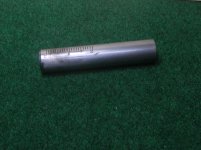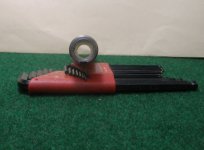I "know" that a Morse taper recess and tenon are supposed to be CLEAN AND DRY and degreased...... but "knowing" and KNOWING can be different things.
My little Grizzly G4003G has a tailstock chuck which I use a lot. I was making a fixture, drilling larger and larger holes clear up to 1" diameter (TOO BIG for the lathe, the drill bit has a 1/2" shank...) and got too big a bite and spun the chuck a few degrees until it jammed. The end of the taper has a large flattened section which extends into the keyslot to engage the wedge. This flattened section ALSO keeps the Morse taper from spinning.
It's not supposed to. It's not DESIGNED this way. But in the past when I've spun the chuck it stops on the flat and I drill away merrily, all the dumber.
So.....I'm drilling away merrily as is my wont and AGAIN I get a BIG bite, like the whole lathe judders......and the tailstock STOPS advancing. Swoll the shaft out and locked it in the journal.....DUHH!
Took me three hours to disassemble the entire tailstock so that I could carefully tap out the parts and spring everything back without scoring.
Got it.
And promptly relieved ALL my Morse tapers which include the flattened beaver tail section so that THEY ALL SPIN FREELY AS DESIGNED!
I got off easy on this one and learned without breaking stuff.....hallelujah
back to work
a liddle wiser
My little Grizzly G4003G has a tailstock chuck which I use a lot. I was making a fixture, drilling larger and larger holes clear up to 1" diameter (TOO BIG for the lathe, the drill bit has a 1/2" shank...) and got too big a bite and spun the chuck a few degrees until it jammed. The end of the taper has a large flattened section which extends into the keyslot to engage the wedge. This flattened section ALSO keeps the Morse taper from spinning.
It's not supposed to. It's not DESIGNED this way. But in the past when I've spun the chuck it stops on the flat and I drill away merrily, all the dumber.
So.....I'm drilling away merrily as is my wont and AGAIN I get a BIG bite, like the whole lathe judders......and the tailstock STOPS advancing. Swoll the shaft out and locked it in the journal.....DUHH!
Took me three hours to disassemble the entire tailstock so that I could carefully tap out the parts and spring everything back without scoring.
Got it.
And promptly relieved ALL my Morse tapers which include the flattened beaver tail section so that THEY ALL SPIN FREELY AS DESIGNED!
I got off easy on this one and learned without breaking stuff.....hallelujah
back to work
a liddle wiser



